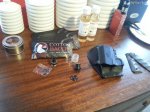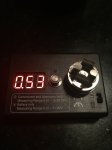I agree with you, I definitely do. I've looked at the site but I don't really know what all of that stuff means. Like I think that's my biggest issue. If I knew what it meant I think I could use the calculators. I've tried searching these forums on it but it's large and I haven't had any luck finding a good write up of a break down for someone as novice as I am. I'll keep looking though, I really want to be better at building and ensuring I'm doing things the best way possible.
Resistance (Ohms) is a measurement of the amount of resistance a material gives against an electrical current. In terms of unregulated boxes, in layman's terms, the lower the resistance the more current is going to flow through the coils. On unregulated mods, lower resistance = more power. But make sure you use a calculator, the lower the resistance the more power your coils get, but also the more amperage is drawn from your battery. Batteries have limits, continuous (10s+) and burst/pulse (1-3s). The average (true, mind you. Just because a wrap says it's xA continuous doesn't mean that rating is true.) is 20A cont, 35-40A burst. There is no TRUE 30A cont 18650 battery. The closest would be the LB HB6, bench tests put it at about 28.5A cont. Also, the lower the MaH (capacity of the battery), the less internal resistance a battery will have. On unregulated mods, this means less battery sag usually. Battery sag is not voltage drop, it's how much current is lost from the battery internally. The more a battery is strained (AKA the more power drawn) the more it will sag. Voltage drop is the amount of power (voltage) lost from the batteries to the atomizer. So when you put a 4.2V battery in a mod, don't assume you're getting 4.2 volts. After sag and drop, imagine around the 3.3-3.7V range depending on how much output power the battery is giving. Keep in mind this is just when a battery is fully charged, the voltage drops as the capacity of the cell does.
On regulated mods, which are usually variable wattage, the resistance doesn't play AS BIG of a role but still definitely plays a role. You're now adjusting yourself with buttons in terms of power, not by builds. The higher the resistance on a regulated mod, the higher the output voltage will be at a given wattage setting. This is a much more complicated realm when compared to unregulated mods, but if you need more information I'm willing to give it.
The thicker the wire (the lower the gauge) the less resistance it will have per foot, also, the more wraps, the more resistance your builds will have. Say you have one coil, it's .6 ohms, say you add a second, identical coil. Your resistance will now be .3 ohms. Certain materials are more conductive, and have less resistance per foot. Like Nichrome, Stainless Steel, etc. These all resist a good bit lower than standard kanthal. The inner diameter (mm/in) of your coils also will determine this, the larger the diameter, the more resistance. The bigger the wire, the less it resists current flowing through it. The bigger the coil, the more it resists, because a larger coil equates to a longer path for the electricity to travel.
Look up Ohm's Law if you need a better feel, and some battery safety information.
Key points:
The thicker the wire (the lower the gauge) the easier it is for current to flow through it, so a lower resistance.
The bigger the coil in terms of wraps and diameter, the more resistance it will have, due to the size making the pathway for electricity longer.
Different wires have different conductivity and resist differently, kanthal is the standard but you have many other wires with a lower resistance.
The lower the resistance, the more power it will draw to your build on unregulated mods, but also this will cause a higher amperage draw. Always make sure your amperage draw is in your batteries limitations, otherwise this is highly unsafe.
On regulated mods the lower the resistance the more wattage it will take to get to a given output power. Like on my DNA200, my .55 build hits the maximum power output of 9V at around 145W, but a .15 build could only reach about 5.5 volts at the full power of 200W.
This is just a crash course, not a full lesson.







